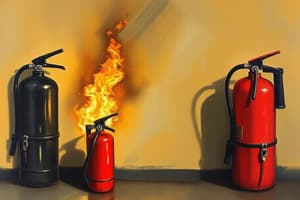Podcast
Questions and Answers
What class of fire burns wood, plastic, rags, rubber, and paper?
What class of fire burns wood, plastic, rags, rubber, and paper?
Class A
What class of fire burns flammable liquids, such as grease, gasoline, oil, oil-based paints, and thinners?
What class of fire burns flammable liquids, such as grease, gasoline, oil, oil-based paints, and thinners?
Class B
What class of fire is in or near electrical equipment?
What class of fire is in or near electrical equipment?
Class C
What class of fire has combustible metals mainly found in factories?
What class of fire has combustible metals mainly found in factories?
What class of fire is related to cooking media like vegetable oils and animal fat?
What class of fire is related to cooking media like vegetable oils and animal fat?
What class of fire extinguisher is used in Class A fires?
What class of fire extinguisher is used in Class A fires?
What class of fire extinguisher uses dry chemical powder for gasoline, oil, and solvents?
What class of fire extinguisher uses dry chemical powder for gasoline, oil, and solvents?
What class of fire extinguisher uses a liquid that turns into gas when it hits the air?
What class of fire extinguisher uses a liquid that turns into gas when it hits the air?
What class of fire extinguisher uses spray dry powder on combustible metals?
What class of fire extinguisher uses spray dry powder on combustible metals?
What class of fire extinguisher uses a pressurized wet potassium acetate-based agent?
What class of fire extinguisher uses a pressurized wet potassium acetate-based agent?
Flashcards are hidden until you start studying
Study Notes
Fire Classes
- Class A: Involves fires from common combustibles such as wood, paper, rags, rubber, and plastics.
- Class B: Comprised of fires from flammable liquids, including grease, gasoline, oil, and paint thinners.
- Class C: Pertains to fires caused by electrical equipment, like appliances, motors, and wiring.
- Class D: Associated with combustible metals, particularly used in industrial settings with materials like magnesium and aluminum.
- Class K: Relates to fires originating from cooking media, primarily vegetable oils and animal fats.
Fire Extinguishers
- Class A fire extinguisher: Specifically designed for Class A fires; utilizes a water-based solution for effective suppression.
- Class B fire extinguisher: Employs dry chemical powder to combat Class B fires, effective against gasoline, oils, and solvents; versatile for multiple fire classes.
- Class C fire extinguisher: Uses gas-producing liquids to tackle Class B and C fires; inappropriate for Class A (risk of spreading) or Class D (explosion hazard).
- Class D fire extinguisher: Contains dry powder specifically for extinguishing fires from combustible metals; critical in factories and industrial environments.
- Class K fire extinguisher: Employs a low pH, potassium acetate-based agent; essential for extinguishing Class K cooking fires, providing safe and efficient suppression.
Studying That Suits You
Use AI to generate personalized quizzes and flashcards to suit your learning preferences.




